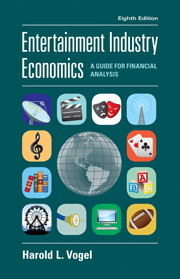Book contents
- Frontmatter
- Contents
- Preface
- Entertainment Industry Economics
- PART I Introduction
- Chapter 1 Economic perspectives
- Chapter 2 Basic elements
- PART II Media-dependent entertainment
- PART III Live entertainment
- PART IV Roundup
- Appendix A Sources of information
- Appendix B Major games of chance
- Appendix C Supplementary data
- Glossary
- References
- Index
- References
Chapter 1 - Economic perspectives
from PART I - Introduction
Published online by Cambridge University Press: 01 June 2011
- Frontmatter
- Contents
- Preface
- Entertainment Industry Economics
- PART I Introduction
- Chapter 1 Economic perspectives
- Chapter 2 Basic elements
- PART II Media-dependent entertainment
- PART III Live entertainment
- PART IV Roundup
- Appendix A Sources of information
- Appendix B Major games of chance
- Appendix C Supplementary data
- Glossary
- References
- Index
- References
Summary
To everything there is a season, and a time to every purpose under the heaven.
– EcclesiastesExtending this famous verse, we can also say that there is a time for work and a time for play. There is a time for leisure.
An important distinction, however, needs to be made between the precise concept of a time for leisure and the semantically different and much fuzzier notion of leisure time, our initial topic. In the course of exploring this subject, the fundamental economic forces that affect spending on all forms of entertainment will be revealed, and our understanding of what motivates expenditures for such goods and services will be enhanced. Moreover, the perspectives provided by this approach will enable us to see how entertainment is defined and how it fits into the larger economic picture.
Time concepts
Leisure and work
Philosophers and sociologists have long wrestled with the problem of defining leisure – the English word derived from the Latin licere, which means “to be permitted” or “to be free.” In fact, as Kraus (1978, p. 38) and Neulinger (1981, pp. 17–33) have noted, leisure has usually been described in terms of its sociological and psychological (state-of-mind) characteristics. And closely tied in to this is the more recent notion that “play” is a fundamental aspect of life.
The classical attitude was epitomized in the work of Aristotle, for whom the term leisure implied both availability of time and absence of the necessity of being occupied (De Grazia 1962, p. 19).
- Type
- Chapter
- Information
- Entertainment Industry EconomicsA Guide for Financial Analysis, pp. 3 - 40Publisher: Cambridge University PressPrint publication year: 2010



